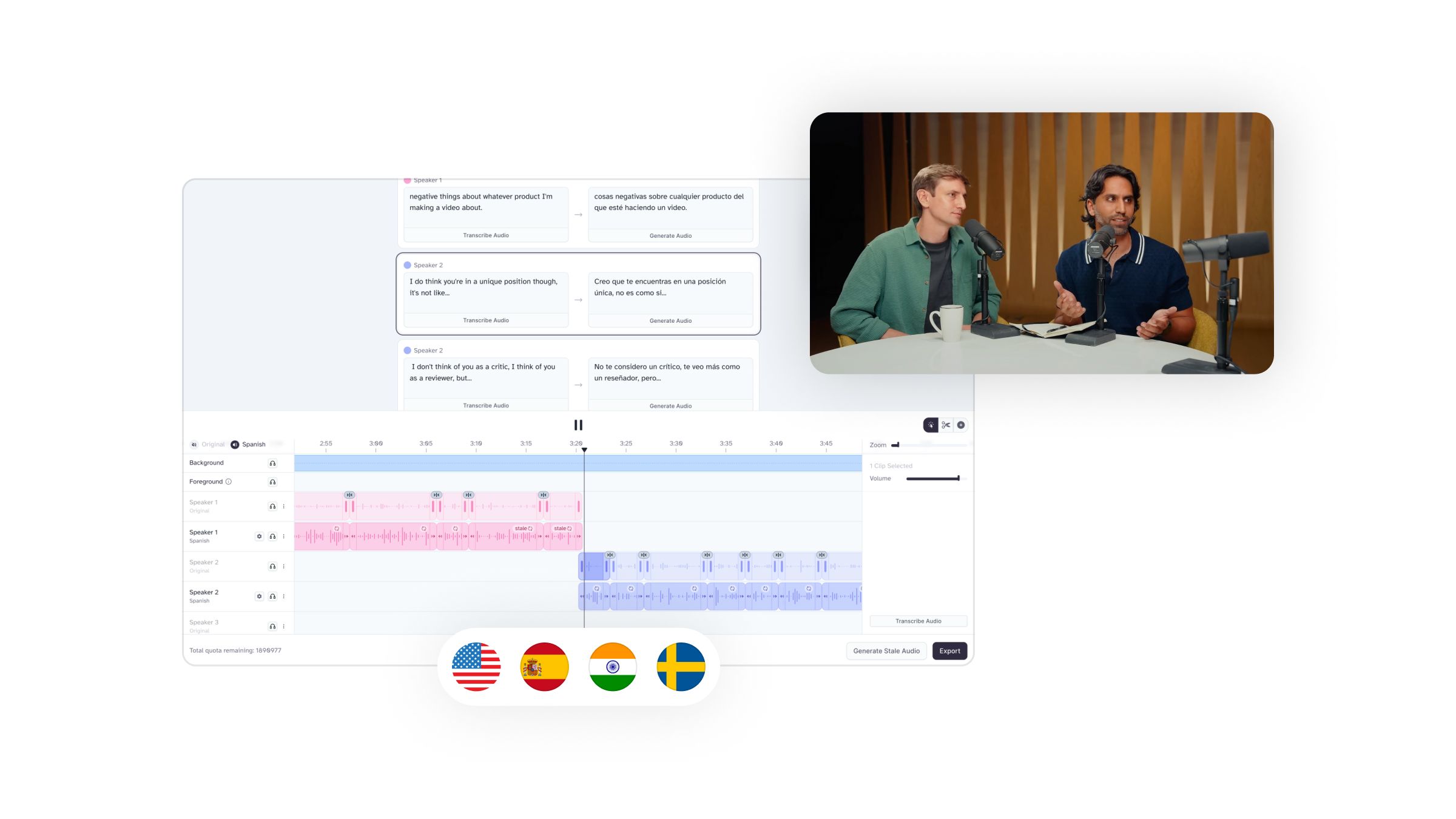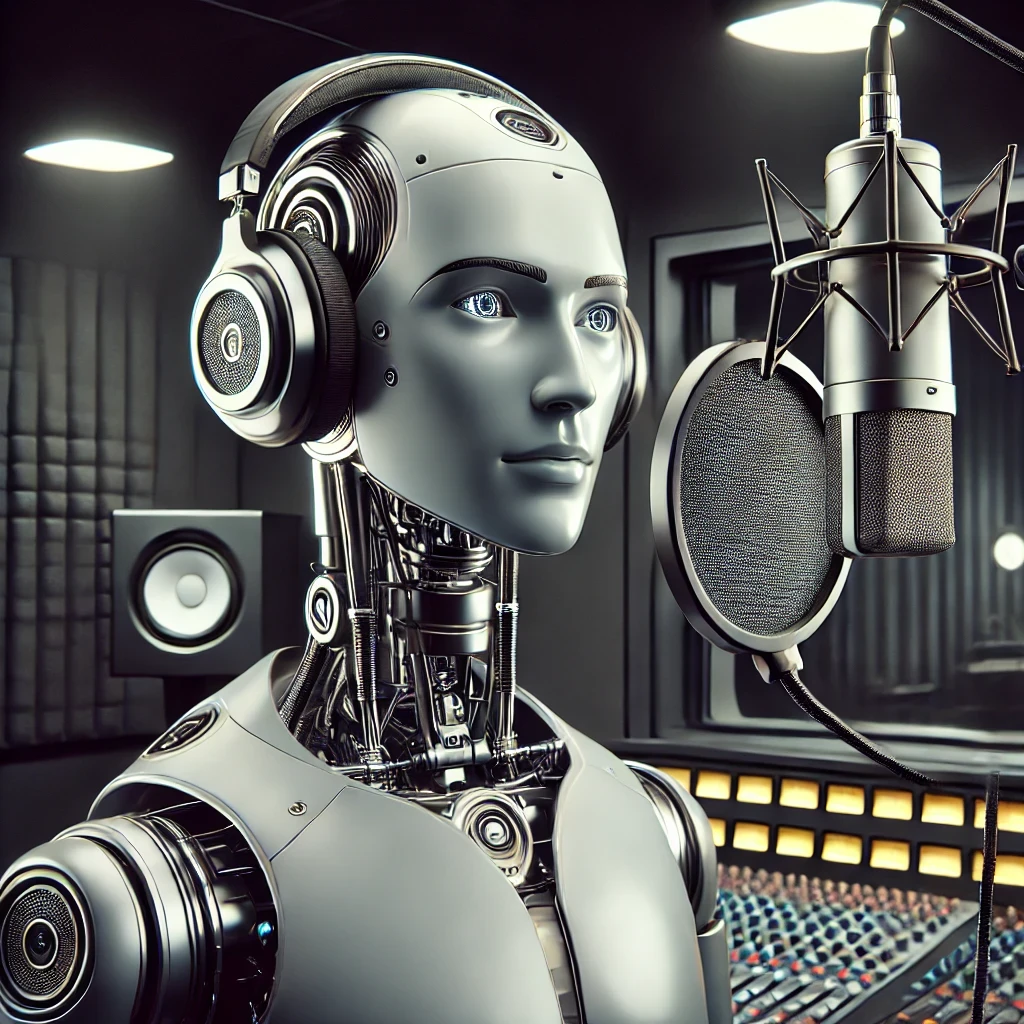
Translate audio and video while preserving the emotion, timing, tone and unique characteristics of each speaker
Video translation and AI dubbing break language barriers, making videos understandable worldwide. In this article, we'll explore what they are and how they work.
Video translation and AI dubbing are revolutionizing content consumption. They enable videos to be understood globally, transcending language barriers. This tech is crucial in a world where videos easily cross borders. It's not just about translating words—it's about preserving the original video's tone, emotion, and context.
Want to get started right away? Try ElevenLab’s AI Dubbing & Video Translator tool for yourself.

Translate audio and video while preserving the emotion, timing, tone and unique characteristics of each speaker
In this article, we delve into what video translation and AI dubbing are, how they work, and why they’re vital if you want to communicate globally.
Video translation and AI dubbing are transforming how we experience content across languages. Unlike traditional dubbing, where human actors tirelessly re-record dialogue, AI dubbing employs sophisticated algorithms for voice replication and content translation.
This technology not only translates words but also captures the original speaker's tone and emotion, offering a more authentic viewing experience.
Neural networks, a type of artificial intelligence that mimics human brain functioning, play a key role in AI dubbing. These networks analyze vast amounts of language data, learning nuances and idiomatic expressions to ensure translations are accurate and culturally relevant.
Moreover, AI dubbing stands out for its efficiency. It significantly reduces production time and costs, making it a viable option for content creators who target a global audience. This is especially critical in a content-rich digital landscape where speed to market can be a competitive edge.
Video translation and AI dubbing is constantly evolving. Ongoing advancements in machine learning algorithms mean that AI can adapt to different dialects and accents, further enhancing the localization of content. This capability is revolutionizing industries like film, television, and online education, where relatable and accessible content is key.
There are 3 main stages in the video translation and AI dubbing process. These are as follows:
This is where it all starts. AI listens to the original video and picks up every spoken word. It's not just about catching words, though. The AI must understand different ways people speak, like various accents or dialects. This ensures everything said in the video is accurately recognized before translating.
Now, it's time to translate. The AI considers the context—the situation or topic of conversation—and cultural nuances. This means it pays attention to how things are said in different cultures to keep the translation accurate and meaningful. It's crucial for jokes, idioms, and expressions to make sense in the new language.
The final step is giving the translated text a voice. AI uses text-to-speech technology to create a voice that sounds natural and matches the original speaker's style. The goal is to make the dubbed version feel as real and authentic as the original.
Underpinning this entire process is machine learning, a kind of AI that gets smarter over time. By learning from each translation, the AI becomes more accurate and better at handling complex language tasks.
Utilizing video translation and AI dubbing tools offers creators several major benefits, especially compared to traditional translation/dubbing methods.
One of the biggest advantages of video translation and AI dubbing is making content accessible to people worldwide. Imagine a popular TV show or educational video. Originally, it's in one language, maybe English. But with AI dubbing, viewers from different countries can watch it in their language. This breaks down language barriers, allowing more people to enjoy and learn from the content, no matter where they are.
Traditionally, dubbing a video into a different language was expensive. It involved hiring voice actors, recording equipment, and a lot of time. AI dubbing changes this. It's a more affordable option because it uses technology, not people, to translate and dub. This means companies can save money while still providing quality content in multiple languages.
AI dubbing is much faster than traditional dubbing. The old way meant recording each line of dialogue, which takes a lot of time. With AI, the translation and dubbing happens almost instantly. This speed means companies can produce and release content in multiple languages much quicker. For industries like news or entertainment, where timing is crucial, this is a significant benefit.
When content is translated and dubbed traditionally, sometimes the original feeling or emotion gets lost. AI dubbing technology aims to keep the original tone and emotion of the speaker. This is important because it helps the audience connect with the content on a deeper level, just like the original audience did.
Discover how video translation and AI dubbing are revolutionizing various industries. From entertainment to education and business, these technologies are breaking language barriers and opening up new possibilities.

In the world of movies, TV shows, and online content, video translation and AI dubbing play a huge role. Imagine watching a foreign movie in your own language without losing the original feel of the characters' voices. That's what AI dubbing does. It allows people from different parts of the world to enjoy content in their language, broadening the audience for filmmakers and content creators.
Education is all about accessibility. With AI dubbing, educational materials like lectures, documentaries, and online courses can reach students globally, regardless of language barriers. This is especially important for e-learning platforms, where content needs to be understandable for learners from various linguistic backgrounds. AI dubbing helps in breaking down these language barriers, making education more inclusive.
For businesses operating internationally, communication is key. AI dubbing comes into play in marketing videos and training materials. By translating and dubbing promotional and training content, companies can reach a wider audience and ensure their employees across the globe receive the same quality of training. This uniformity is crucial for maintaining the company's standards worldwide.

Eleven Labs offers a tool that allows content translation across 29 languages quickly, with features like voice translation, speaker detection, and audio dubbing. You can upload from various sources like YouTube, TikTok, or even directly via URL. The tool maintains the original voice style and efficiently handles multiple speakers.

Rask AI specializes in creating transcripts, translations, and voiceovers with unique features like voice cloning and lip-sync (currently in Beta). It supports translation from nearly any language to over 130 languages, making it versatile for a variety of projects.
.webp)
Dubdub.ai offers AI dubbing in over 40 global languages. It's tailored for a variety of content types, including educational and documentary videos. The platform promises quick turnaround times, easy collaboration, and context-aware translations for a better dubbing experience.
Each of these tools provides unique features and capabilities, making them suitable for a range of video translation and AI dubbing needs. When choosing a platform, consider factors like language support, ease of use, and specific features that align with your project requirements.
Video translation and AI dubbing are groundbreaking technologies changing how we share and consume content globally. They break down language barriers, making videos accessible to a diverse audience.
AI dubbing, especially, preserves the original emotion and style, offering a more authentic experience. Tools like Eleven Labs play a crucial role in this transformation, offering efficient and accurate dubbing in multiple languages.
These innovations are not just about understanding different languages—they're about connecting people and cultures. Interested in experiencing this technology firsthand? Give ElevenLabs' voice translation and AI dubbing tool a try and see how it can transform your content.

Translate audio and video while preserving the emotion, timing, tone and unique characteristics of each speaker

Localize videos with precise control over transcript, translation, timing, and more

AI dubbing and voice translation are changing the game